Agricultural Literacy Curriculum Matrix
Lesson Plan
Melons, Mitosis, and Meiosis
Grade Level
9 - 12
Purpose
Students apply the steps of mitosis and meiosis to learn about the production of both seeded and seedless watermelon. Students will learn about the discovery of colchicine, which made seedless watermelon possible and use modeling clay and beans to model meiosis and mitosis. Grades 9-12
Estimated Time
2 Hours
Materials Needed
Activity 1: Modeling Mitosis in Watermelons
- Mitosis/Meiosis PowerPoint
- Mitosis Graphic Organizer
- Clay or play-dough
- 20-30 beans per student
- Cups to hold beans (optional)
- Sticky notes or scrap paper
Activity 2: Modeling Meiosis in Seeded Watermelons
- Mitosis/Meiosis PowerPoint
- Meiosis Graphic Organizer
- Clay or play-dough
- 20-30 beans per student
- Cups to hold beans (optional)
- Sticky notes or scrap paper
Activity 3: Modeling Meiosis in Seedless Watermelon
- Seedless Watermelon Meiosis Wheel, 1 per student
- Scissors
- Brass fasteners, 1 per student
- Clay or play-dough
- 20-30 beans per student
Vocabulary
adapt: to change so as to fit a new or specific use or situation
chromosome: a threadlike structure of nucleic acids and protein found in the nucleus of most living cells, carrying genetic information in the form of genes
colchicine: a poisonous alkaloid c22H25No6 that inhibits mitosis, is extracted from the corms or seeds of the autumn crocus (colchicum autumnale), and is used especially in the treatment of gout and to produce polyploidy in plants
diploid: cells that have two complete sets of chromosomes, one from each parent
hybrid: the offspring of two plants or animals of different species or varieties
meiosis: the cellular process that results in the number of chromosomes in gamete-producing cells being reduced to one half and that involves a reduction division in which one of each pair of homologous chromosomes passes to each daughter cell and a mitotic division
mitosis: a process that takes place in the nucleus of a dividing cell, involves typically a series of steps consisting of prophase, metaphase, anaphase, and telophase, and results in the formation of two new nuclei each having the same number of chromosomes as the parent nucleus
tetraploid: having or being a chromosome number four times the monoploid number
triploid: having or being a chromosome number three times the monoploid number
Did You Know?
- Watermelon is 92% water.1
- The first cookbook published in the U.S. in 1776 contained a recipe for watermelon rind pickles.1
- Seedless watermelon production began its evolution in 1939, however they didn't find a large market until the late 20th century.2
- Half of the watermelons grown in California are seedless.2
Background Agricultural Connections
Mitosis, Meiosis, and Watermelons
Both mitosis and meiosis are processes that reproduce cells. Mitosis produces exact genetic copies of cells to allow growth as well as to replace worn out cells. One cell can divide into two cells, called daughter cells. Each cell has an exact and identical copy of DNA with a full set of chromosomes. The chromosomes are threadlike structures found in the nucleus of living cells carrying genetic information, known as DNA, in the form of genes. In the case of watermelons, they have 22 chromosomes. Mitosis divides cells allowing one cell to become two, two cells to become four, and so on. Mitosis allows watermelon to grow from small to large. For this lesson student's understanding for sexual and asexual reproduction would be required for helping them gain an understanding for producing a hybrid such as seedless watermelons.
Meiosis differs from mitosis in that it only takes place in the reproductive organs to produce gametes, or reproductive cells. Reproductive cells are produced through the process of meiosis. Meiosis is different than mitosis because it produces cells with only half the total number of chromosomes. In the case of a watermelon, the male sperm cell and the female ovule each have 11 chromosomes. When fertilization takes place a single cell is formed with a complete set of 22 chromosomes.
Development of the Seedless Watermelon
O.J. Eigsti was a botanist and plant geneticist from Goshen, Indiana who discovered that colchicine, a chemical derived from crocus plants, could cause a plant to double its chromosomes. A Japanese scientist named Kihara used Eigsti’s chromosome-doubling process to produce the first seedless watermelon.
The seedless watermelon is a hybrid, a cross between two different kinds of watermelon. Since the purpose of seeds is reproduction, Kihara had to develop a watermelon that could not reproduce. The normal watermelon is called a diploid because it has two sets of chromosomes per cell (di- means two). By treating normal watermelon seedlings with Eigsti’s discovery, colchicine, Kihara produced watermelons with twice as many chromosomes in each cell. This watermelon, called a tetraploid, had four sets of chromosomes per cell (tetra- means four).
For Kihara, the next step was to cross-breed a tetraploid with a normal diploid as the pollinator. Since cells from each plant contribute half their chromosomes in the reproduction process, the result was a triploid plant. Triploids have three sets of chromosomes per cell (tri- means three). This triploid seed will germinate and grow into a triploid plant bearing triploid male and female flowers, but the flowers will not produce viable sperm-bearing pollen or eggs because of the odd number of chromosome sets (3). With three sets of chromosomes, one set will not have a matching set to pair up with during meiosis. When flowers of this sterile triploid plant (called the seedless watermelon plant) are pollinated by a normal plant, seedless fruits develop.
When you buy seedless watermelon seeds, you get two kinds of seeds, one for the fertile diploid plant and one for the sterile triploid. The triploid seeds are larger, and both types of seeds are planted in the same vicinity. Male flowers of the diploid plant provide the pollen which pollinates (but does not fertilize) the sterile triploid plant. The act of pollination induces fruit development without fertilization, so the triploid watermelons are seedless.
Commercial Production of Seedless Watermelon
Most commercial watermelon growers do not grow triploid watermelon from seed because it is too expensive. The seed of diploid watermelon costs about five cents per seed, the seed of triploid watermelon costs about 30 cents each. Triploid seed is also very sensitive to temperature and overwatering.
Instead of planting seed in the field, growers buy plants from companies that start the seed under very restricted conditions. The seeds are placed in a soilless mix, watered only once, soon after planting, and covered with plastic. They are kept at temperatures between 90 and 100 degrees F. for 2-3 days, until they germinate. At that time they are moved to a greenhouse where they are treated like any other plant.
After 2-3 weeks they are shipped out to the watermelon fields for planting, where they grow vigorously, like any other watermelon. However, they must be planted with regular diploid watermelons for pollination.
Because the seeds in a triploid watermelon are infertile, the melon adapts by adjusting to the new conditions. The inner, red fruit is often firmer than a seeded watermelon because it does not soften to cushion developing seeds. For this reason, it can also be kept longer on the grocery store shelf.
Engage
- Ask your students this challenge question and discuss possible answers: “What do a mule and a seedless watermelon have in common?” Neither can reproduce! (They are both hybrids—a mule is a cross between a female horse [mare] and a male donkey [jack]—and neither can reproduce.)
- Next, ask your students to think of other hybrids such as clementine oranges and boysenberries and list their reasons for creating such varieties. (quality of fruit is better or meeting customer preferences and demands)
- Tell students they will be learning about conditions that help create hybrids such as a seedless watermelons.
Explore and Explain
Activity 1: Modeling Mitosis in Watermelons
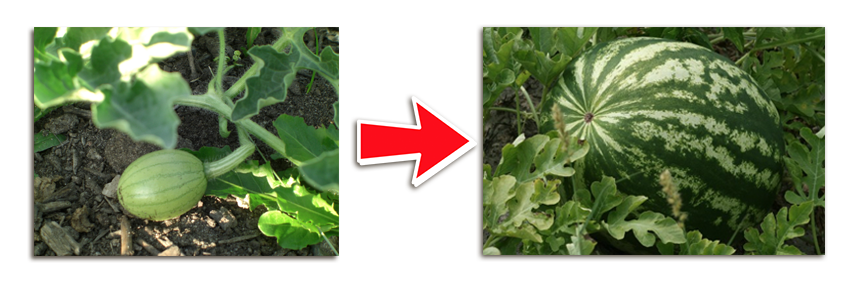
- Review the phases and purpose of mitosis with your students by asking them, "What is the purpose of mitosis?" Their responses should refer to cell regeneration and cell growth in the form of asexual reproduction. For example, human skin cells will undergo mitosis to heal a wound from an injury.
- Use the Mitosis/Meiosis PowerPoint to review the stages; Prophase, Metaphase, Anaphase, Telophase, and Interphase.
- Give each student a copy of the Mitosis Graphic Organizer. Have them complete the graphic organizer and share results with a partner. Allow students to make any corrections needed while sharing responses with a partner. Insert graphic organizers into interactive notebooks if available.
- Conduct a class review to be sure your students understand that mitosis creates new cells called daughter cells by duplicating existing cells. Every cell should contain one set (2 copies) of chromosomes. Mitosis allows for growth. A small watermelon can grow into a large watermelon through the process of mitosis.
- Provide each student group (individually or in pairs) with modeling clay and 20-30 small beans. Different colors of beans can be used; however, remind students that when homologous chromosomes pair up, or chromatids duplicate, the colors must match. Separate the beans ahead of time for easy distributing.
- Instruct students to divide the clay into five parts. Each part will represent a stage in mitosis: Interphase, Prophase, Metaphase, Anaphase, and Telophase.
- Ask students to model each stage of mitosis using the beans to represent chromatids and chromosomes.
- Using sticky notes, have students label each stage of mitosis and describe what is happening.
- Help students model each stage of mitosis. Repeat as necessary until you are confident students understand this process. The Mitosis Graphic Organizer and PowerPoint can be used as resources.
- Consider asking the following questions as students work on their mitosis models:
- After mitosis has occurred, why are the daughter cells identical? (Because chromosomes duplicated and then separated.)
- Why do organisms need mitosis? (For growth and damaged cell repair.)
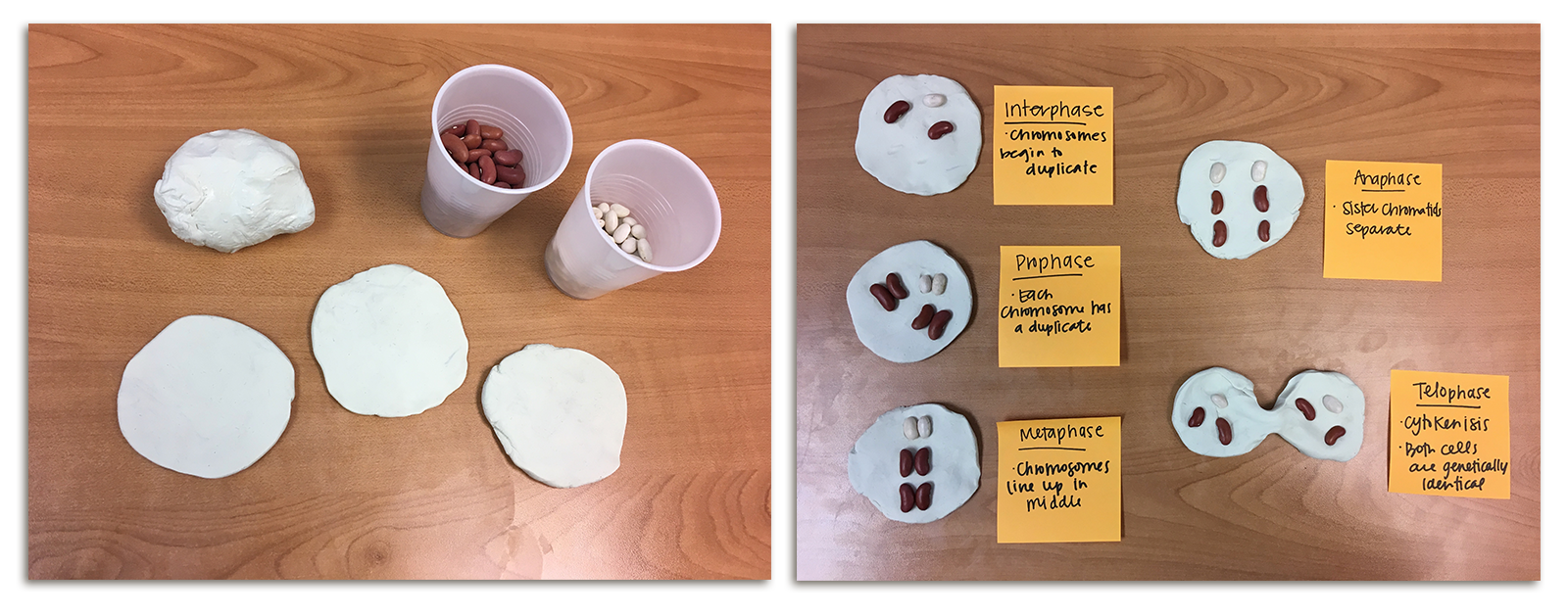
Activity 2: Modeling Meiosis in Seeded Watermelons

- Review the process and principles of meiosis. Students should understand that the purpose of meiosis is the production of gametes for sexual reproduction. Meiosis produces the male (pollen containing sperm) and female (ovule) gamete. Each gamete contains half of the typical number of chromosomes.
- Use the Mitosis/Meiosis PowerPoint to review the stages; Prophase I, Prophase II, Metaphase I, Metaphase II, Anaphase I, Anaphase II, Telophase I, and Telophase II.
- Point out that seeded watermelons have 22 chromosomes, so each gamete contains 11 chromosomes. Watermelon vines contain both male and female flowers. The male flower pollinates the female flower which develops into the seed bearing fruit which can be planted to produce more watermelons.
- Give each student a copy of the Meiosis Graphic Organizer. Have them complete the graphic organizer and share results with a partner. Allow students to make any corrections needed while sharing responses with a partner. Insert graphic organizers into interactive notebooks if available.
- Ask students to model the process of meiosis using the clay and beans. Remind students that this time they will have to model Prophase I, Metaphase I, Anaphase I, Telophase I, and Prophase II, Metaphase II, Anaphase II, and Telophase II.
- Explain that normal watermelons are called diploid because they have cells with two sets of chromosomes. (Single sets of chromosomes are called haploids. Duplicate pairs of chromosomes are called chromatids.)
- Consider asking students the following questions as they complete their meiosis models:
- Do humans have diploid or haploid cells? (Diploid because we have 2 sets of chromosomes: half from our mom [23], and half from our dad [23]. Our reproductive cells [sperm and egg cells] are haploid because they contain 23 single sets.)
- What is the purpose of meiosis? (To produce reproductive cells [pollen/sperm cells and egg cells].)
- Why is crossing over in Prophase I important? (This creates genetic diversity so all reproductive cells contain different traits.)
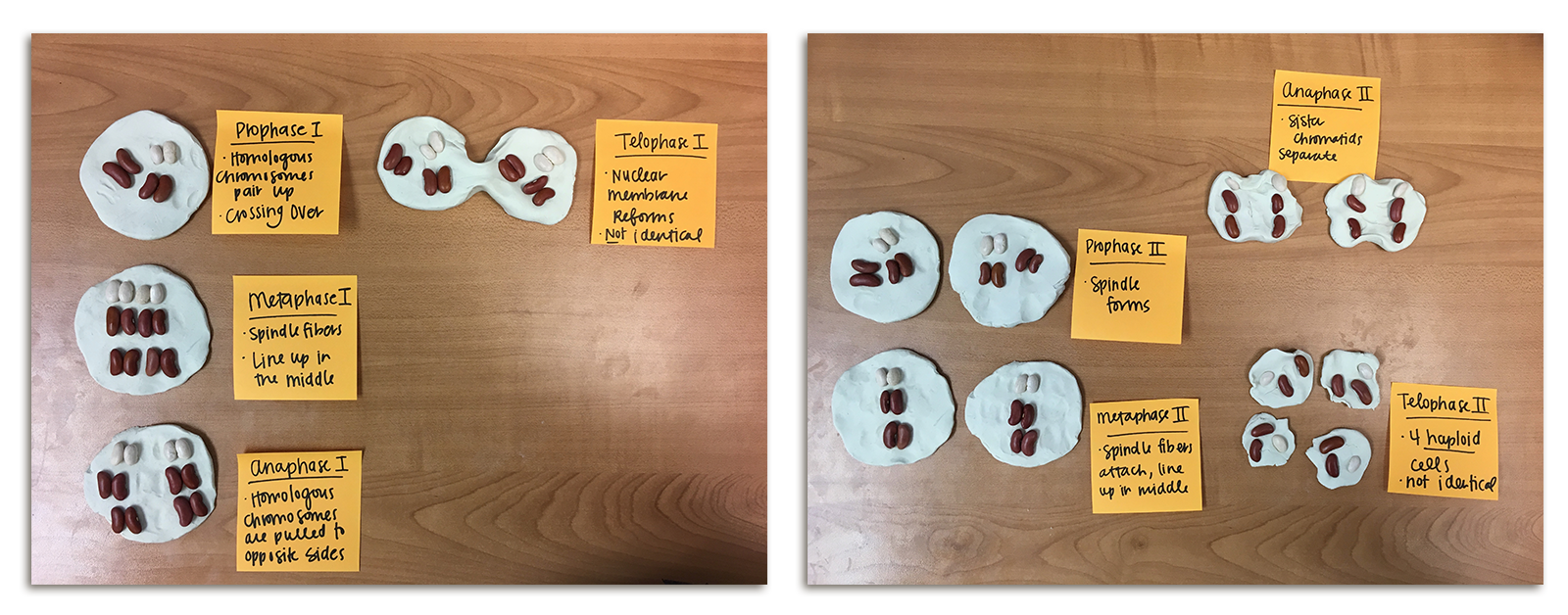
Activity 3: Modeling Meiosis in Seedless Watermelon

- Use the information located in the Background Agricultural Connections section and the video clip, SEEDLESS Watermelon - You'll Never Guess How It's Grown, to teach students about the genetics of a seedless watermelon. Be sure your students understand that “diploid” means two chromosomes, “triploid” means three, and “tetraploid” means four. Discuss the meanings of the prefixes “di-,” “tri-,” and “tetra.”
- Pass out a Seedless Melon Meiosis Wheel to each student.
- Instruct students to color and illustrate a picture in each of the blank spaces representing each description and step of seedless watermelon meiosis. Students may need to follow along with the video again for help.
- Ask students to cut out each of the circles and secure with a fastener. The big wheel should go on bottom, with the descriptions in the middle, and the illustrations on top.
- Instruct students to cut down each of the dotted lines on the illustrated wheel, creating flaps.
- Insert wheels into interactive notebooks, if available.
- Allow students to practice lining up the correct step with the corresponding description and illustration.
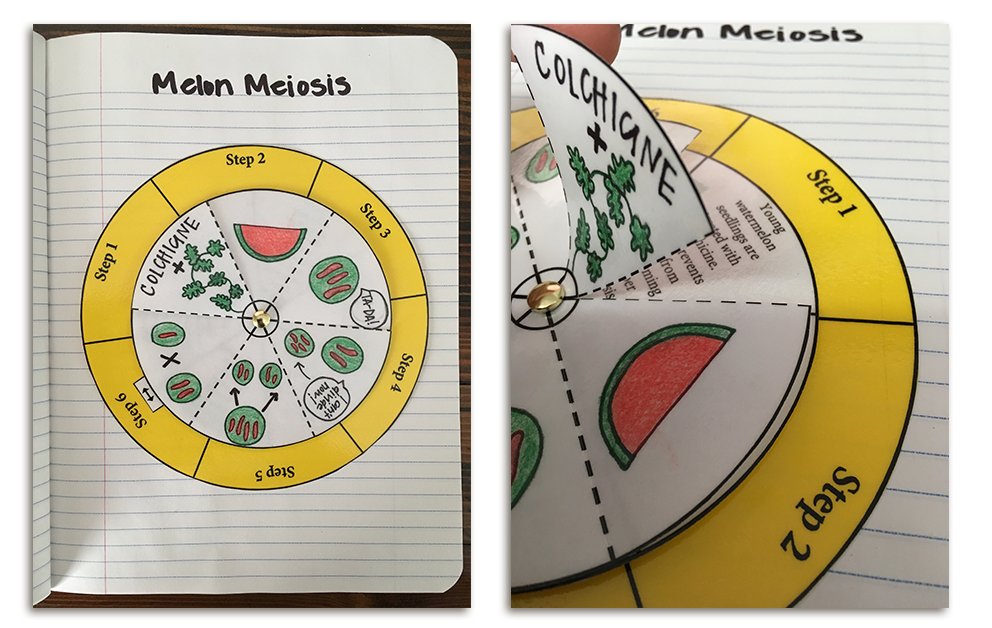
- If extra time remains, ask students to model seedless watermelon meiosis using the clay and beans.
- Ask students to explain why the reproductive process would not work with the resulting triploid cell.
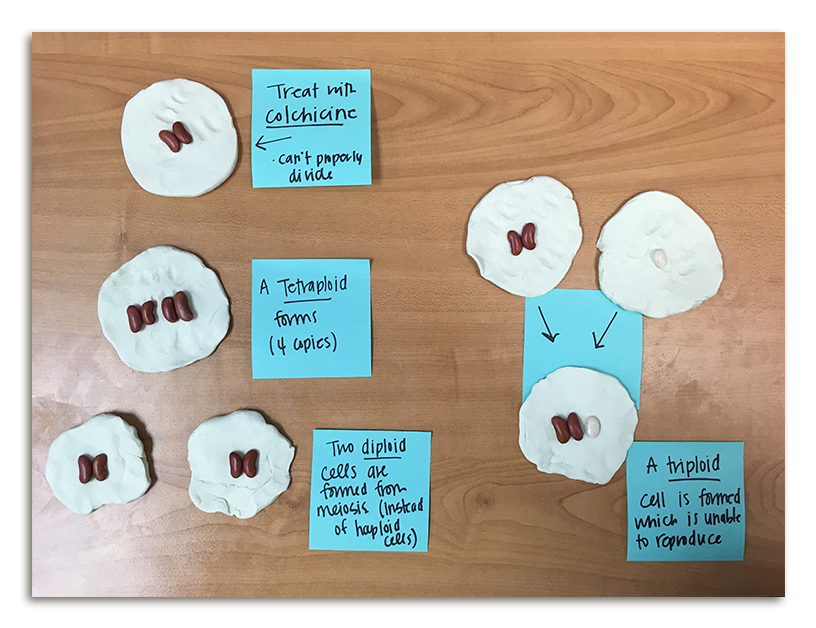
Elaborate
- Assign students to discover other fruits and vegetables that are seedless and research to find out if they are produced by a process similar to that used to produce seedless watermelons.
- Divide students into groups of three or four. Each group will design an imaginary watermelon. Students will use their imaginations and give the invented watermelon any trait they would like. Then, develop market plans for their new watermelons and present them to the class, using technology as appropriate.
- Give students one coffee filter and tempera paint. Instruct students to place tempera paint dots in a pattern of their choice on one half of a round coffee filter. Fold the circle to duplicate the design on the other side. Explain that this demonstrates how our cells’ blueprint plan can be repeated. Each cell has chromosome pairs that can divide to form a new set of chromosomes.
- Show the America's Heartland episode, Watermelon Farmer. The 5-minute video highlights a watermelon farm in Alabama.
Evaluate
At the conclusion of this activity, review and summarize the following key concepts:
- Hybrids are produced in agriculture to provide a commodity or food product that offers more desirable traits to the consumer.
- Mitosis and meiosis are vital cellular processes for the existence of living things such as a hybrid. Mitosis replicates non-sex cells for growth, and meiosis produces cells for sexual reproduction.
- Biological careers such as a botanist and plant geneticist are necessary in the field of agriculture for developing plants that can adapt and grow under a variety of environmental conditions to produce healthy food.
Sources
Acknowledgements
This lesson was adapted from the lesson, Melon Meiosis, written by Oklahoma Agriculture in the Classroom
Recommended Companion Resources
Author
Andrea Gardner and Bekka Israelsen
Organization
Utah Agriculture in the Classroom and National Center for Agricultural Literacy (NCAL)
| We welcome your feedback! If you have a question about this lesson or would like to report a broken link, please send us an email at matrixelearning@gmail.com. If you have used this lesson and are willing to share your experience, we will provide you with a coupon code for 10% off your next purchase at AgClassroomStore. |
